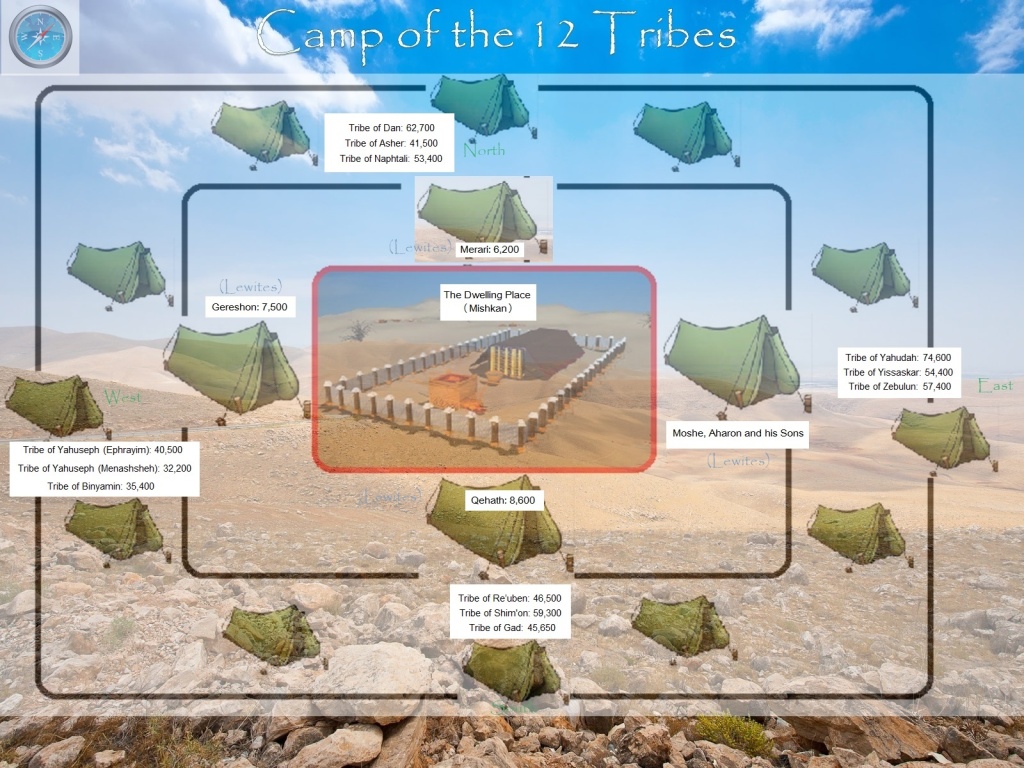Bamidbar- Shared Reading
Torah Portions 4.1 Bamidbar (Bamidbar) Chapters 1:1-4:20
Hebrew Word/Phrase of the Week: Bamidbar
Meaning: ”In the Wilderness”
The Torah Portion this week is called Bamidbar (במדבר), meaning, “In the Wilderness”. YHWH tells Moshe what order the children of Yashra’el should camp around the Dwelling Place, every time they travel in the wilderness.
Chapter 1: This week, we begin with YHWH telling Moshe to count all the men. Specifically, this count was for all the men that would ever need to fight in a battle, from 20 years old and above. All were grouped into divisions, by their tribe, and each group was assigned a leader from their own tribe.
Here are the Numbers:
- Tribe of Re’uben: 46,500
- Tribe of Shim’on: 59,300
- Tribe of Gad: 45,650
- Tribe of Yahudah: 74,600
- Tribe of Yissaskar: 54,400
- Tribe of Zebulun: 57,400
- Tribe of Yahuseph (Ephrayim): 40,500
- Tribe of Yahuseph (Menashsheh): 32,200
- Tribe of Binyamin: 35,400
- Tribe of Dan: 62,700
- Tribe of Asher: 41,500
- Tribe of Naphtali: 53,400
Fun Fact: The Tribe of Yahudah was the largest tribe counted. They had almost 12,000 more men then the next largest tribe, the Tribe of Dan! If you took the Tribe of Menashsheh and added them with the Tribe of Asher, the Tribe of Yahudah would still have 900 more men.
All together, 603,550 men were counted for battle. But did you notice something? A tribe is missing from the count. Twelve tribes were counted, but this is because the Tribe of Yahuseph is broken into two groups, Ephrayim and Menashsheh. As for the Lewi’s, these were YHWH special Kohamin (Priests), and were not to be counted. The count was for the men that would go into battle only. The priests had other responsibilities, such as maintaining the Dwelling Place of YHWH, preparing offerings daily, taking the Dwelling Place down and setting it back up every time they moved the camp. That was a lot!
Chapter 2: Next, YHWH told Moshe how the people should be separated every time they set-up camp. Like how you would get in line for lunch at school, but in assigned groups. Every time they camped and moved camp, this was how they moved out in order, with their own group’s banners:
- East Side: Yahudah, Yissakar, then Zebulun (These guys would depart first.)
- South Side: Reuben, Shimon, then Gad (the second to depart.)
- West Side: Ephrayim, Menashsheh, then Binyamin (third to depart.)
- North Side: Dan, Asher, then Naphtali (They depart last)
Fun Fact: Where was the Mishkan, and where were the Lewites in all this?
The Mishkan would be right in the center, and then surrounded by the Lewite’s camp. Then all the other groups were outside of them each on their assigned sides.
Chapter 3: Unlike the other tribes, the Lewites would be counted by every male that was one month old and above, and the Lewites were to be separated into three large groups:
Gereshon, Qehath and Merari
The group of Gereshon: Was 7,500 males from a month old and above. Though all the Lewites camped in the middle around the Mishkan, the Gereshonites camped on the west side (of the middle). Their duty was the Dwelling Place, the tent and its covering, the covering of the door of the Tent of Meeting, the screens of the courtyard and the covering of the door of the courtyard.
The group of Qehath: Listed 8,600 males from a month old and above. They camped on the South side of the Dwelling Place (in the middle). Their duty was the ark, the table, the lamp stand, the altars, the utensils of the set-apart place used in the service, the covering, and all its service items.
The group of Merari: 6,200 males a month old and above. They camped North of the Dwelling Place (in the middle). The appointed duty of the children of Merari was the boards of the Dwelling Place, its bars, its columns, its sockets, its utensils, and all its service. This also included the columns of the courtyard all around, their sockets, and their pegs, and their cords.
Fun Fact: This took care of the west, north and south sides of the Dwelling Place (Mishkan), but what about the East?
Well, Moshe and Aharon and his sons camped there.
Why were Lewites important?
“Now look, I Myself have taken the Lewites from among the children of Yashra’el instead of every first-born who opens the womb among the children of Yashra’el. And the Lewites shall be Mine, because all the first-born are Mine. YHWH tells Moshe to bring the tribe of Lewi near to Aharon the Kohen (priest), and to serve him and the duty of the Tent of Meeting (Mishkan). All together, there were 22,000 Lewites, from month old and above. YHWH told Moshe that instead of all the first-born male children of Yashra’el and the livestock, he was taking the Lewites in their place. When Moshe counted all the first-born males of Yashra’el, there was 22,273. Though this was almost even, the exact number mattered to make this an even exchange. So for every person more (the 273 extra), they were ransomed for 5 sheqels each. The silver (1,365 sheqels) was given to Moshe, who gave it to Aharon and his sons.
Fun Fact: Yashra’elite Torah Teachers have taught that 300 of the Lewites were first-born, so they had to redeem themselves and would not be counted in the total amount of Lewites listed (22,300 – 300= 22,000 listed)
Chapter 4: Remember the sons of Qehath mentioned earlier? Because their duty included the most set-apart items in the Dwelling Place, they actually had to wait for Aharon and his sons to first properly cover all the set-apart items in layers of leather and blue wrapping before it was even safe for them to lift the items. These items were so set-apart, that only Aharon and his sons were able to touch them. This meant that not only did they have to covered before the sons of Qehath could even lift these items, but they couldn’t even watch the items get covered or they would die.
Want to know more? Join us next time as we continue to read through Bamidbar (Numbers)!


